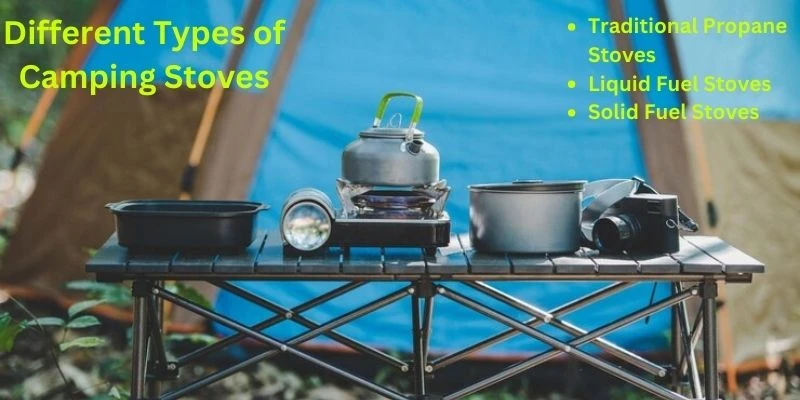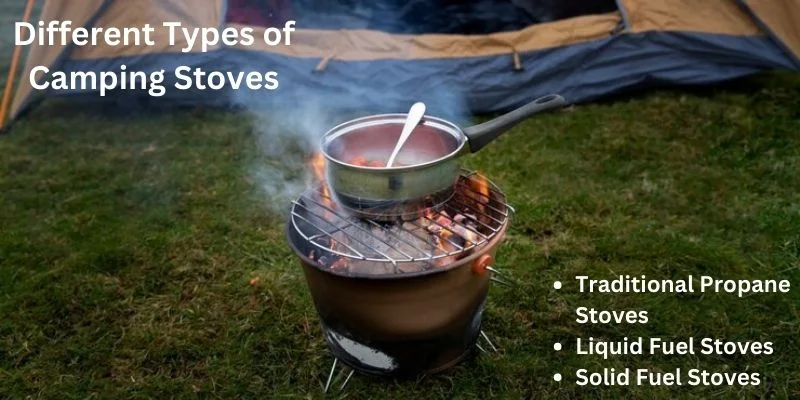Discover the Top 5 Different Types of Camping Stoves for Adventurous Outdoor Cooking
Updated: 5 Mar 2024
184
Camping is a beloved outdoor activity that allows us to reconnect with nature and escape the hustle and bustle of everyday life. One essential aspect of any camping trip is cooking meals, and a reliable camping stove can make all the difference. However, with so many options available on the market, choosing the right camping stove can be overwhelming.
In this article, we’ll compare different types of camping stoves to help you make an informed decision for your next outdoor adventure.
Different Types of Camping Stoves
There are different types of camping stoves. But it depends upon the weather conditions and the camping style or nature of camping. So when selecting the stoves for camping, be careful to consider all the important points before finalizing the best stove.

Having the right camping stove is crucial at Pawna Lake camping. Whether you prefer portable gas stoves for quick meals or versatile wood-burning stoves for a traditional feel, your choice can enhance your outdoor cooking experience.
1. Traditional Propane Stoves
Propane stoves are popular among campers due to their convenience and ease of use. These stoves typically consist of a burner attached to a propane fuel canister. They are quick to set up and provide consistent heat output, making them ideal for cooking meals or boiling water. Propane stoves come in various sizes and designs, ranging from compact single-burner models to larger multi-burner units suitable for group camping.
Pros and Cons of Traditional Propane Stoves
| Pros |
|---|
|
| Cons |
|---|
|
2. Liquid Fuel Stoves
Liquid fuel stoves, such as those powered by white gas or kerosene, offer versatility and reliability in various camping conditions. These stoves typically feature a refillable fuel tank and a pump mechanism for pressuring fuel. They are known for their ability to perform well in extreme weather conditions, including cold temperatures and high altitudes.
Pros and Cons of Liquid Fuel Stoves
| Pros |
|---|
|
| Cons |
|---|
|
3. Solid Fuel Stoves
Solid fuel stoves utilize compact fuel sources such as tablets or cubes made from compressed chemicals. These stoves are lightweight, portable, and easy to use, making them popular for backpackers and minimalist campers. Solid fuel stoves are often used for boiling water rather than cooking elaborate meals due to their limited heat output.
Pros and Cons of Solid Fuel Stoves
| Pros |
|---|
|
| Cons |
|---|
|
Comparison
Here’s a comparison table highlighting the key features of Traditional Propane Stoves, Liquid Fuel Stoves, and Solid Fuel Stoves:
| Feature | Traditional Propane Stoves | Liquid Fuel Stoves | Solid Fuel Stoves |
| Fuel Type | Propane | Liquid fuel (white gas, kerosene, etc.) | Solid fuel tablets or cubes |
| Portability | Portable | Portable | Lightweight and portable |
| Setup | Quick and easy | Requires priming before use | Minimal setup |
| Heat Output | Consistent | Adjustable | Limited |
| Versatility | Compatible with various cookware | Compatible with various cookware | Limited to boiling water |
| Performance in Extreme Conditions | Moderate | Excellent | Limited |
| Availability of Fuel | Widely available | May require specialty fuel | Automatic shut-off valves, built-in windscreens |
| Convenience | Easy to use and refill | Moderate | Fuel tablets are widely available |
| Safety Features | Automatic shut-off valves, built-in wind screens | Automatic shut-off valves, built-in windscreens | Minimal safety features |
| Ideal For | General camping trips | Extreme conditions (cold, high altitude) | Backpacking, minimalist camping |
This table concisely compares the main features and characteristics of traditional propane stoves, liquid fuel stoves, and solid fuel stoves, helping campers choose the right option based on their specific needs and preferences.

Choosing Your Perfect Stove
1. Weight
Backpacking? Prioritize lightweight canisters or alcohol stoves. Car camping? Liquid fuel or a heftier canister system might be fine.
2. Group Size
Need to feed a crew? Opt for a powerful liquid fuel stove or a large canister system.
3. Cooking Style
Fancy meals? Canister or liquid fuel with simmer control is best. Boiling water only? A basic canister stove will suffice.
Climate
Cold weather camping? Liquid fuel or canister stoves with winter performance features are key.
Stove Best Accordingly To Weather
When it comes to weather, here’s the breakdown of which camping stove performs best:
Warm Weather
Canister Stoves are the clear winner for warm weather. They’re lightweight, user-friendly, and boil water quickly. Their clean-burning nature is also a plus.
Cold Weather
Liquid Fuel Stoves: These reign supreme in the cold. Liquid fuel, like white gas, performs much better than canister fuel, which can struggle to vaporize in frigid temperatures. Some canister stoves have features to mitigate this, but liquid fuel remains the most reliable option.
Here’s a table summarizing the weather performance:
| Weather Condition | Best Stove Type | Reasoning |
| Warm Weather | Canister Stove | Lightweight, fast boil times, clean burning |
| Cold Weather | Liquid Fuel Stove | Reliable fuel performance, powerful enough for low temperatures |
Additional Considerations
- Wind: A windscreen can benefit canister and liquid fuel stoves in windy conditions. This helps maintain heat and fuel efficiency.
- Shoulder Seasons (Spring/Fall): If you’re camping during shoulder seasons, a canister stove with good winter performance (like an inverted canister stove) could be a good compromise. However, a liquid-fuel stove might be safer if you anticipate freezing nights.
Remember: Safety first! Always follow the manufacturer’s use, fuel handling, and maintenance instructions.
Conclusion
When choosing a camping stove, consider your specific needs and camping style. Propane stoves offer convenience and ease of use, while liquid fuel stoves provide versatility and reliability in extreme conditions. Solid fuel stoves are lightweight and portable, making them ideal for backpacking adventures. By understanding the advantages and disadvantages of each type of camping stove, you can select the one that best suits your outdoor cooking needs.
FAQs
What are the different types of camping stoves available?
The different types of camping stoves include propane stoves, liquid fuel stoves, canister stoves, wood-burning stoves, and alcohol stoves.
How do propane camping stoves work?
Propane camping stoves use pressurized propane gas to fuel the burners. The gas is ignited by a spark or flame, producing a steady flame for cooking.
What are the advantages of liquid fuel camping stoves?
Liquid fuel camping stoves are versatile and can run on various types of liquid fuel, such as white gas, kerosene, or diesel. They perform well in cold weather and at high altitudes.
Are canister stoves easy to use?
Yes, canister stoves are generally easy to use. They use pre-filled fuel canisters that easily screw onto the stove. They are lightweight and compact, making them ideal for backpacking and camping trips.
How do wood-burning camping stoves differ from other types?
Wood-burning camping stoves use twigs, sticks, and other biomass materials as fuel. They are environmentally friendly and do not require carrying fuel, but they may take longer to cook food compared to other stoves.
What are the benefits of alcohol camping stoves?
Alcohol camping stoves are lightweight, compact, and easy to refill. They are also relatively inexpensive and can be made from household items such as soda cans. However, they may have slower cooking times compared to other stoves.
Can camping stoves be used indoors?
It is not recommended to use camping stoves indoors due to the risk of carbon monoxide poisoning and fire hazards. They should only be used in well-ventilated outdoor areas.
Please Write Your Comments